The Season Begins
/6 Comments/in Design, Vegetables/by Lee ReichOne More Thing? Ha!
I have one more important task to do before planting any vegetables this spring, and that is the annual mapping out of the garden, something I generally put off as long as possible.
In theory, mapping out my garden should be easy. I “rotate” what I plant in each bed so that no vegetable, or any of its relatives, grows in a given bed more frequently than every 3 years. 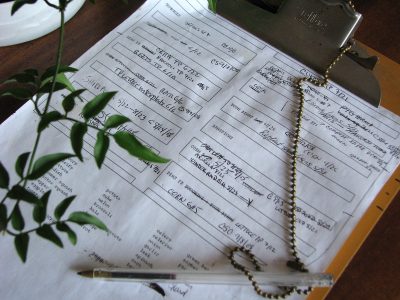 In practice, I mostly pay attention to rotation of plants most susceptible to diseases, which are cabbage and its kin (all in the Brassicaceae), cucumber and its kin (Cucurbitaceae), tomato and its kin (Solanaceae), beans and peas (Fabaceae), and corn (sweet or pop, in the Gramineae).
In practice, I mostly pay attention to rotation of plants most susceptible to diseases, which are cabbage and its kin (all in the Brassicaceae), cucumber and its kin (Cucurbitaceae), tomato and its kin (Solanaceae), beans and peas (Fabaceae), and corn (sweet or pop, in the Gramineae).
Crop rotation prevents buildup of disease pests that overwinter in the ground; removing host plants eventually starves them out. (Insect pest are more mobile, so crop rotation has less impact except in very large plantings.) So one year a bed might be home to cucumbers, melons or squashes. The next year that bed might host cabbage, broccoli, kale, Brussels sprouts, or cauliflower. Then tomatoes, peppers, potatoes, or eggplants. And finally, the fourth year, back to cucumbers. Simple enough.
It would also be nice to rotate carrots and other root vegetables with leafy vegetables, such as lettuce, and fruiting vegetables, such as tomatoes. 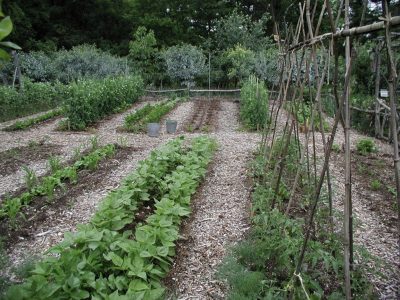 Root, leafy, and fruiting vegetables have somewhat different nutrient needs, so in the ideal garden these crops are rotated to make best use of soil nutrients.
Root, leafy, and fruiting vegetables have somewhat different nutrient needs, so in the ideal garden these crops are rotated to make best use of soil nutrients.
And I do like to get the most out of my garden and confuse potential insect pests by grouping different kinds of plants within a bed.
Are you beginning to understand why I put off committing my garden plan to paper each spring?
Pea Problem(s)
Peas present one more wrinkle in my vegetable garden planning.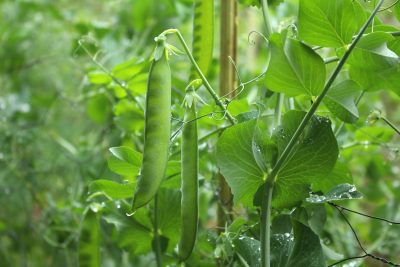 A few years ago they stopped bearing well, collapsing with yellowing foliage not long after they bore their first pods.
A few years ago they stopped bearing well, collapsing with yellowing foliage not long after they bore their first pods.
Further investigation has narrowed the problem to – probably – one of two diseases: fusarium or aphanomyces. Both, unfortunately, are long-lived in the soil so that a 3 year rotation does nothing to keep them in check.
Fortunately, I have two vegetable gardens. So, for the past few years I have banned peas from my north garden, planting them only in my south garden, in which they do get rotated. After a few more years, I’ll move the pea show to my north garden and leave my south garden pea-less. I’ve also been planting the varieties Green Arrow and Little Marvel, both of which are resistant to fusarium, at least.
Unfortunately, the problem is more likely aphanomyces, for which resistant varieties do not exist. Aphanomyces is a water mold, so thrives under wet conditions. So my tack will also be to keep any peas planted in my vegetable garden on the dry side, not even turning on the drip irrigation in those beds.
I’ll also be checking the plants more closely for symptoms. Plants infected by fusarium have a red discoloration to their roots. 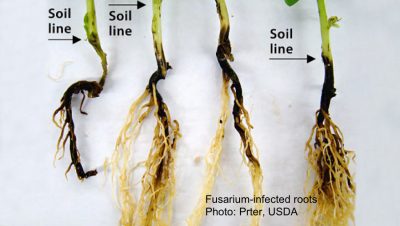 Plants infected by aphanomyces have fewer branch roots and what roots there are lack the plump, white appearance of healthy roots.
Plants infected by aphanomyces have fewer branch roots and what roots there are lack the plump, white appearance of healthy roots.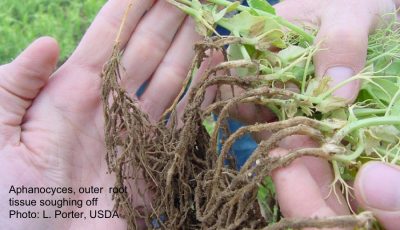
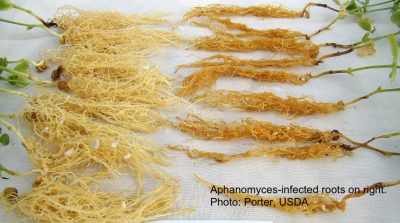
Pea Solution?
I’m also testing out root drenches with compost tea for my peas.
Yes, yes, I know I have dissed compost tea in the past. Mostly, its benefits, if any, have been overstated. But compost microbes have more chance of surviving in the dark, moist, nutrient-rich environment of the soil than on a leaf, where the stuff is often sprayed. I’m drenching the soil with the tea, not just giving the surface a spray, as usually recommended, so a lot more bacteria, fungi and friends are finding their way down there.
I see no reason (and research does not support) of going to the trouble of making the usual compost tea, which is aerated and might be fortified with such things as molasses. 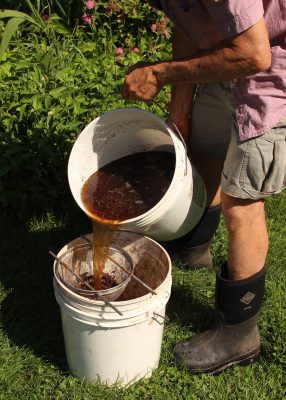 My tea is nothing more than the liquid strained from compost soaked in water, then applied with a watering can at the base of the pea plants.
My tea is nothing more than the liquid strained from compost soaked in water, then applied with a watering can at the base of the pea plants.
I’ve done this for a couple of seasons but have nothing definite to report yet. The hard part is sacrificing a bed as a control. Perhaps this year.
Increasing My Hyacinthal Holdings
/3 Comments/in Flowers, Gardening/by Lee ReichHyacinth City
I’ve admitted this before; here’s more evidence of my addiction — to propagating plants. I currently have a seed flat that’s only 4 by 6 inches in size and is home to about 50 hyacinth plants. Obviously, the plants are small. But small and sturdy.
The genesis of all these plants goes back a couple of years when I needed photos for my book The Ever Curious Gardener: Using a Little Natural Science for a Much Better Garden. For the chapter on some aspects of the science of plant propagation and the practical application of that science, I made photos of some methods of multiplying hyacinth bulbs. Here’s an excerpt of that section:
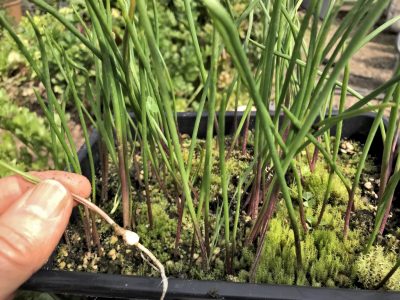 “Knowing what a bulb really is makes it easier to understand how they can multiply so prolifically that their flowering suffers, and how to get them to multiply for our benefit. Dig up a tulip or daffodil and slice it through the middle from the tip to the base. What you see is a series of fleshy scales, which are modified leaves, attached at their bases to a basal plate, off of which grow roots—just like an onion (but, in the case of daffodil, poisonous!). The scales store food for the bulb while it is dormant.
“Knowing what a bulb really is makes it easier to understand how they can multiply so prolifically that their flowering suffers, and how to get them to multiply for our benefit. Dig up a tulip or daffodil and slice it through the middle from the tip to the base. What you see is a series of fleshy scales, which are modified leaves, attached at their bases to a basal plate, off of which grow roots—just like an onion (but, in the case of daffodil, poisonous!). The scales store food for the bulb while it is dormant.
That bottom plate is the actual stem of the plant, a stem that has been telescoped down so that it’s only about a half-inch long. Those fleshy scales are what store food for the bulb, and, depending on the kind of bulb, are nothing more than modified leaves or the thickened bases of leaves.
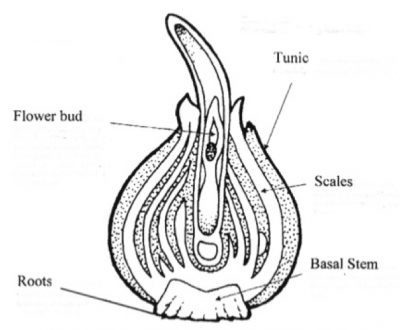 Look at where the leaves meet the stems of a tomato vine, a maple tree—any plant, in fact—and you will notice that a bud develops just above that meeting point. Buds likewise develop in a bulb where each fleshy scale meets the stem, which is that bottom plate. On a tomato vine, buds can grow to become shoots; on a bulb, buds can grow to become small bulbs, called bulblets. In time, a bulblet graduates to become a full-fledged bulb that is large enough to flower.”
Look at where the leaves meet the stems of a tomato vine, a maple tree—any plant, in fact—and you will notice that a bud develops just above that meeting point. Buds likewise develop in a bulb where each fleshy scale meets the stem, which is that bottom plate. On a tomato vine, buds can grow to become shoots; on a bulb, buds can grow to become small bulbs, called bulblets. In time, a bulblet graduates to become a full-fledged bulb that is large enough to flower.”
Natural Increase
“Let’s see just how the big three flowering bulbs—tulips, daffodils, and hyacinths—grow. With tulips, the main bulb, the one that flowers, disintegrates right after flowering and is replaced by a cluster of new bulblets or bulbs. The mother bulb of a daffodil continues to grow after flowering, at the same time producing offsets of bulbs or bulblets which may remain attached to the mother bulb. Hyacinths grow the same way as daffodils, except for being much more reluctant to make babies.
All those bulblets and bulbs can, in time, crowd each other for light, food, and water, so flowering suffers. When my daffodils, tulips, or hyacinths seem to be making too many leaves and too few flowers, I know it’s time to dig them up and separate all the bulbs and bulblets. The best time for this operation is just as the foliage is dying back in spring or early summer because after that plants are out of sight until the following spring. Replanting can be done immediately or delayed until autumn.”
The Scoop on Propagating Bulbs
“Knowing something about bulb structure also gives me inside information on how to multiply my holdings faster, perhaps to make enough plants for a whole field or a giant flower bed. Merely digging up and planting offsets is one way of doing this. Also, knowing that the bottom plate is a stem and that the offsets come from side buds lets me coax those side buds to grow just as can be done with any other stem.
Pinching out the growing tip of any stem makes side buds grow. One way you get rid of, or ‘pinch out,’ the growing tip of a bulb is to turn the bulb upside down, then scoop out the center of the bottom plate with a spoon or knife.  Another way is to score the bottom plate with a knife into 6 pie shaped wedges, making each score cut deep enough to hit that growing point.
Another way is to score the bottom plate with a knife into 6 pie shaped wedges, making each score cut deep enough to hit that growing point.  After scoring or scooping, set the bulb in a warm place in dry sand or soil for planting outdoors in a nursery bed in autumn.
After scoring or scooping, set the bulb in a warm place in dry sand or soil for planting outdoors in a nursery bed in autumn. After a year, as many as 60 bulblets might be sprouting from the base of each scooped or scored bulb. Each bulblet does take 4 or 5 years to reach flowering size, but no matter. To quote an old Chinese saying: ‘The longest journey begins with the first step.’”
After a year, as many as 60 bulblets might be sprouting from the base of each scooped or scored bulb. Each bulblet does take 4 or 5 years to reach flowering size, but no matter. To quote an old Chinese saying: ‘The longest journey begins with the first step.’”
My little hyacinth bulblets are now in their second season of growth. I’ll keep them growing strongly until their leaves yellow as they go naturally dormant, probably late this spring. Come fall, I’ll dig them all out, separate them, and then plant them out in a nursery bed or else in their permanent homes. I expect aromatic bliss in a couple of years.
And, On Another Note
I was recently a guest on Susan Poizner’s radio show/podcast where we talked about growing uncommon fruits, here at my farmden and in general. Hear it at https://orchardpeople.com/growing-uncommon-fruits/
A Farmdener, That’s Me
/16 Comments/in Design, Flowers, Fruit, Gardening, Vegetables/by Lee ReichA New Word is Introduced
I’d like to introduce the words farmden and farmdener into the English language. I wonder if there are any other farmdeners out there.
What is a farmden? It’s more than a garden, less than a farm. That’s my definition, but it also could be described as a site with more plants and/or land than one person can care for sanely. A gardener and garden gone wild, out of control.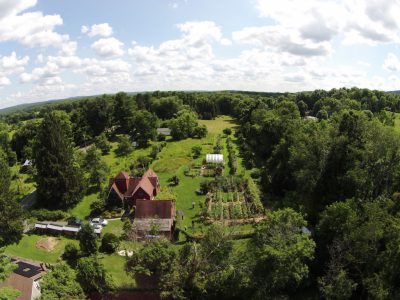
You might sense that I speak from personal experience. I am. My garden started innocently enough: A 30 by 40 foot patch of vegetables, a few apple trees, some flowers, and lawn. That was decades years ago, and in the intervening period, the lawn has grown smaller, the vegetable garden has doubled in size, and the fruit plantings have gone over the top.
Originally, I had less than acreage – 72 hundredths of an acre to be exact. But over the course of 15 years, I did manage to put my fingers onto almost every square foot of that non-acre. Squeezed into that area were 40 varieties of gooseberries, a dozen varieties of apples, a half dozen varieties of grapes, red currants, white currants, black currants, raspberries, mulberries: you get the picture. All that, in addition to my vegetables, flowers, and some shrubbery. But I was still not a farmdener, and my property was not a farmden.
Evolution of My Farmden
The transition from garden to farmden occurred with the purchase of a fertile acre-and-a-half field bordering the south boundary of my property.
With that purchase, I expanded my plantings, rationalizing that because I write about gardening (for magazines, for Associated Press, and for this blog) and host workshops here, I should test and grow a lot of what I write and talk about. So instead of 2 hardy kiwifruit vines such as any normal gardener might grow, I planted 20 vines of a few species and varieties. Instead of 2 pawpaw trees, à la normal gardener, I planted 20 pawpaw trees of few varieties.

Pawpaws, blackcurrants, and hardy kiwis
And how about another dozen apple trees? And chestnuts, filberts, pine nuts (Pinus koreansis is hardy here in New York’s Hudson Valley). Again, you get the picture.
But no, I wasn’t finished. There was always one more plant needing a home, one more piece of ground hungry for a plant. Why not create another vegetable garden; after all, I had just gotten married, and that made another mouth to feed. Why buy vegetables when you have enough land to grow them?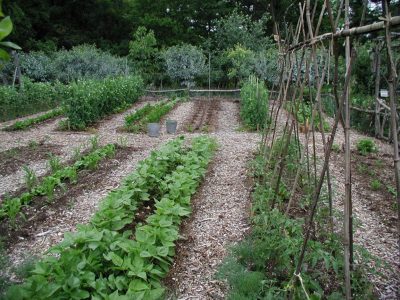 And what about winter? A greenhouse full of salad and cooking greens solved that problem, in addition to providing figs in summer and early and late season cucumbers.
And what about winter? A greenhouse full of salad and cooking greens solved that problem, in addition to providing figs in summer and early and late season cucumbers.
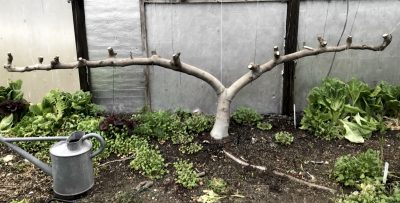
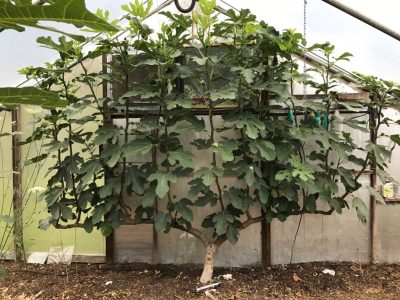
I like crown imperial (Fritillaria imperialis) flowers and learned the quirks of propagating them – pack pieces of bulb scales in moist potting soil and subject them to a few months of warm temperatures, then a few weeks of cool temperatures, pot up, plant out. Soon I had not a crown imperial or two such as you might find in most gardens, but dozens of them, and more still coming on.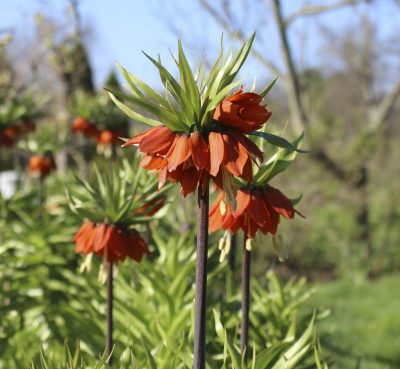
You might imagine that, despite my plantings, my lawn still grew bigger with that increased acreage. Not so. Most of the acre and a half, except what was devoted to new plantings, became a hayfield that I mowed and helped feed my compost pile. A bit of rationality prompted me to graduate from scything to a small farm tractor for brush hogging that field. (Tennis elbow, the result of excessive scything, also helped with that decision. But I still use the scythe, a high quality Austrian style scythe, to mow parts of the field.)
Present and Future
What I now had – and have – is a farmden. And I am a farmdener. A farmden is not something from which you can earn a living, although I have sold some excess pawpaws, American persimmons, and hardy kiwifruits, mostly for test marketing in my efforts to see whether these fruits are worth promoting for small farms. (They are; flavor sells.)
And my farmden is a great venue for workshops, as long as I point out that participants should pay attention to my plants, not the number of them, because my property is obviously the handiwork of a crazed gardener (or a sane farmdener?). “Don’t try this at home,” I tell participants right off the bat.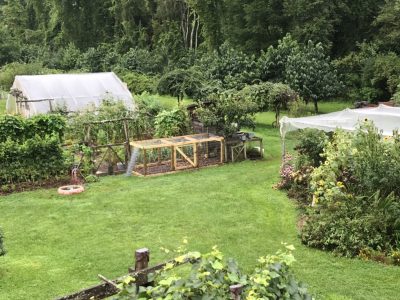
I do occasionally still garden. Right next to my terrace is a bed with tree peonies, potentiillas, clove currants, and Signet marigolds, all well-contained by the bricks of the terrace on one side and a low, moss-covered hypertufa wall on the other side. The bed is close to the house and the bed is small. Yesterday I noticed weeds starting to overstep their limit in the bed. I crouched down, started at one side of the bed, and gave it a thorough weeding, literally getting my hands on every square inch of soil. It was fun and it was quick.
Most of my time, though, is spent farmdening. It’s very satisfying, even if it does get crazy sometimes, and it yields a cornucopia of very tasty and healthful fruits and vegetables, many of them planted with an eye to beauty as well as function.
I have vowed not to plant anything more in the hayfield, in large part because it’s so pretty, the soft violet hue from midsummer’s monarda flowers grading over into a golden glow from late summer’s goldenrods. I also promised my daughter, when she was young and enthralled with Laura Ingalls Wilder, that we would leave most of the field as “prairie.” (Now over 30 years old, my daughter no longer yearns for prairies, but I’m keeping my promise.)
I have taken some of the edge off the transition from gardening to farmdening with some help here on the farmden from an occasional helper. Still, I am planning to keep the “den” in farmden.

